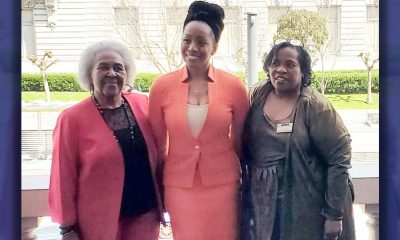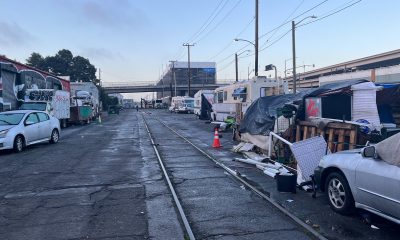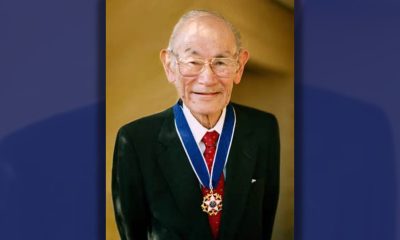Bay Area
Verdese Carter Park Gang Violence Forces Kids’ Football Team to Find New Site to Play
Gang violence is raging in Deep East Oakland, also known as “Bossland,” where gun shots are heard daily, and recently, youth and the East Bay Panthers football team had to duck and cover twice in one month at Verdese Carter Park at 9600 Bancroft Ave. The Park has become the epicenter of violent activity despite a police station embedded there.
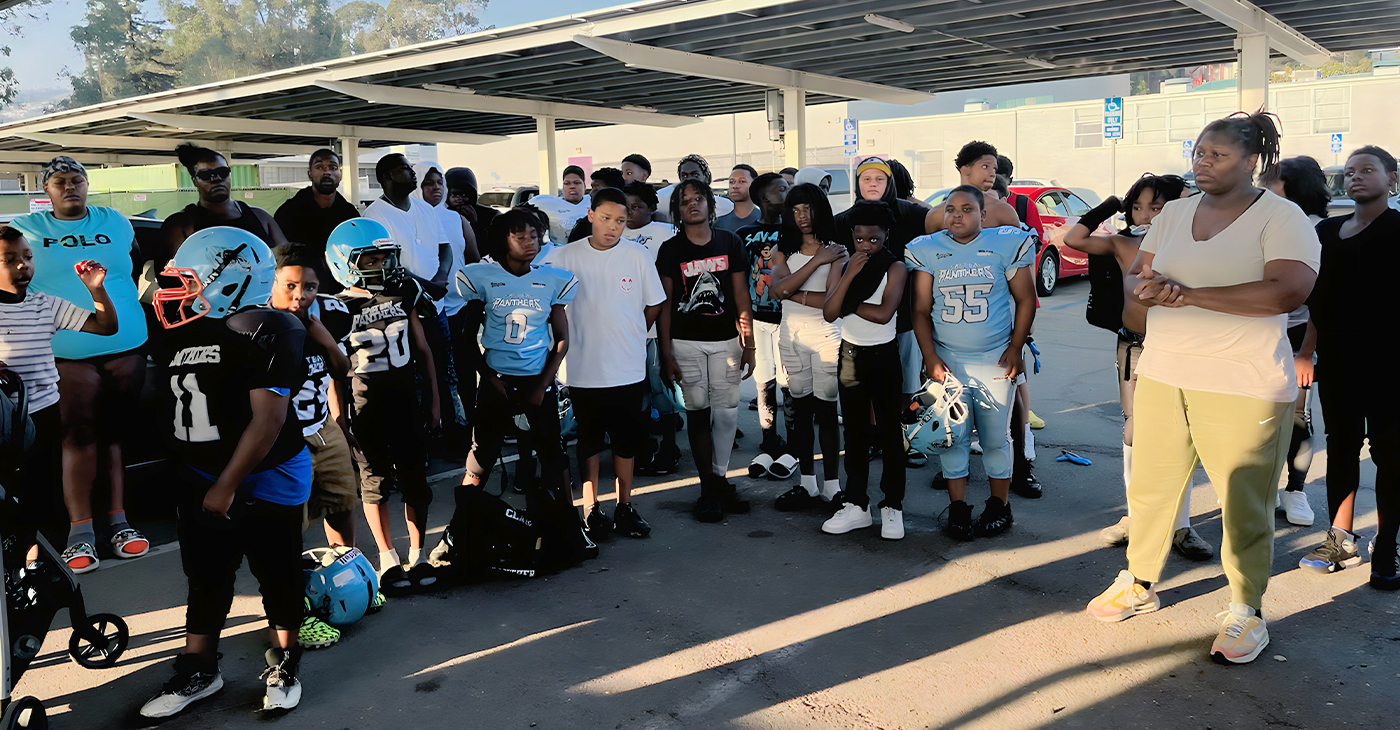
By Tanya Dennis
Gang violence is raging in Deep East Oakland, also known as “Bossland,” where gun shots are heard daily, and recently, youth and the East Bay Panthers football team had to duck and cover twice in one month at Verdese Carter Park at 9600 Bancroft Ave. The Park has become the epicenter of violent activity despite a police station embedded there.
Jacob Davis, coach of the East Bay Panthers says, he will no longer bring his team to the park after shooting incidents on Aug. 24 and Aug. 29 where kids ages 5 -14 were caught in gang crossfire and had to take cover.
Tamu Lopez, treasurer of The East Bay Panthers, and accountant for Adamika Village#stopkillingourkidsmovement has two children on the team, Micah Lopez, 10, and Caleb Lopez, 14. Lopez says “My children are traumatized. My youngest, Micah, has had several nightmares since the violent encounters and neither of my sons want to play football anymore. Both are afraid to go to any park and want to leave Oakland.”
Davis notes that his team is a safety net, sometimes the only source of food for the kids, when they don’t have access to school meals or school activities.
“For many, belonging to the East Bay Panthers is their only positive outlet. We thought we’d be safe in the park because, until now, we thought Verdese Carter Park was a neutral zone for the gangs, but no longer. The police don’t respond, they don’t come here after 4 p.m. and we practice from 5:30 to 7.”
The Panthers are not the only group of children who are in danger. “We have five organizations that need to practice where they are safe: The Eastbay Warriors, 510 Legacy, Bay Area Lions, Oakland Dynamite and the East Bay Panthers for our girls and boys ages 5 – 14.”
Representing Oakland Mayor Sheng Thao, Pati Navalta responded that the Oakland Police Department (OPD) recognizes the uptick in violent crime and gun violence. “The Department is dedicated to utilizing all available resources to focus on individuals committing violent crimes, and we have increased our presence in areas experiencing this uptick. We are also collaborating with our neighboring law enforcement partners to address the recent surge,” Navalta said.
District Attorney Pamela Price responded saying, “The District Attorney’s office does not control or regulate the Oakland Police Department however, we are committed to prosecuting gang members and others who cause death or injury in our community to the full extent of the law.”
Davis said immediate safety solution is that Oakland Unified School District allow teams to practice on their fields. The problem currently is OUSD charges a fee to utilize the fields that we cannot afford.”
When asked if Oakland Unified would consider this proposal, John Sasaki, director of Communications promised to investigate the feasibility of Davis’ proposal.
Adamika Village#stopkillingourkidsmovement believe they have the solution to ending gang violence at Verdese Carter.
CEO Daryle Allums says. “Adamika Village hosts Town Night events funded by the Department of Violence Prevention and prior to, during, and a month after our last town night, crime and violence plummets. That’s because Adamika Village brings a different type of energy and people feel it! We bring love, hope, gifts, money, testing for COVID and flu, food, entertainment, and a kid zone. We provide a safe place; we are out here actively making a difference!”
Give Adamika Village the park for one year, before the city starts remodeling, Allums said, and “we will create ongoing ‘Town Nights’ with education, cooking programs that provide food to eat while they learn good nutrition. We’ll get Alcohol Anonymous out here to intervene in the drug culture and we’ll invite the Black Muslims to speak on health, lifestyle and self-control.”
When questioned about the cost Allums responded, “As we organize in the streets, we need people to organize behind the desk. Our Black girls are being kidnapped, our elder women are getting robbed, our people have stopped coming out.
“Let Adamika rebuild what has been lost. The soil at the park is corrupted. It’s contaminated with community violence, it’s toxic. Adamika will shift that energy so we can heal our people who are addicted to violence, who know nothing else.”
Activism
Oakland Post: Week of April 24 – 30, 2024
The printed Weekly Edition of the Oakland Post: Week of April 24 – 30, 2024
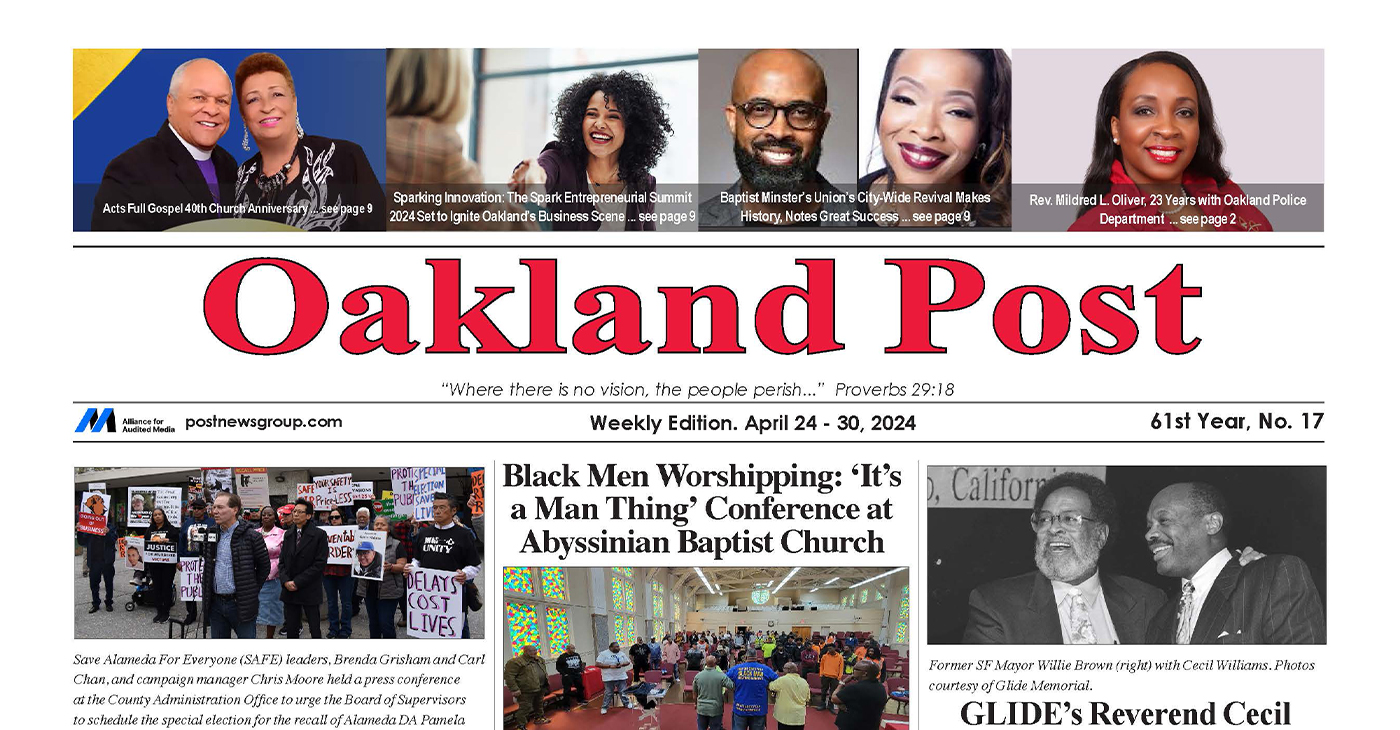
To enlarge your view of this issue, use the slider, magnifying glass icon or full page icon in the lower right corner of the browser window. ![]()
Alameda County
DA Pamela Price Stands by Mom Who Lost Son to Gun Violence in Oakland
Last week, The Post published a photo showing Alameda County District Attorney Pamela Price with Carol Jones, whose son, Patrick DeMarco Scott, was gunned down by an unknown assailant in 2018.
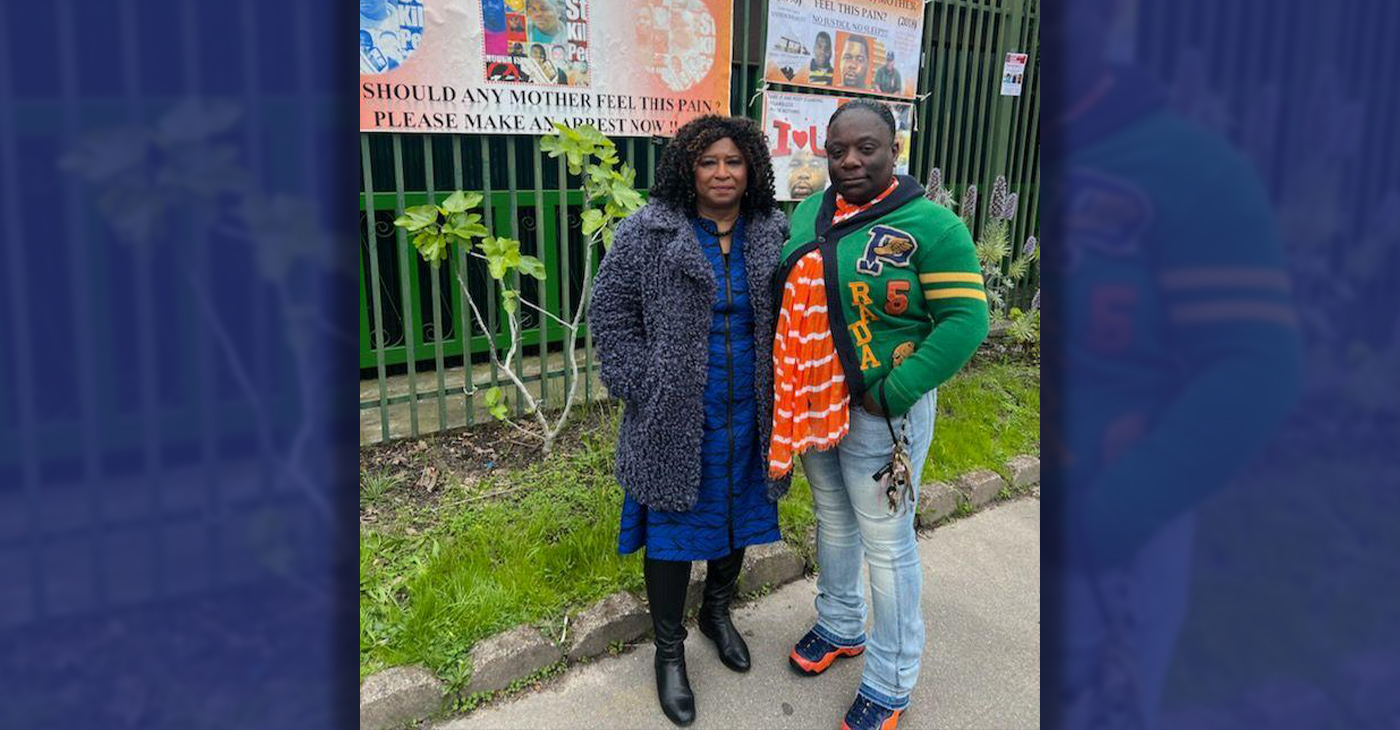
Publisher’s note: Last week, The Post published a photo showing Alameda County District Attorney Pamela Price with Carol Jones, whose son, Patrick DeMarco Scott, was gunned down by an unknown assailant in 2018. The photo was too small for readers to see where the women were and what they were doing. Here we show Price and Jones as they complete a walk in memory of Scott. For more information and to contribute, please contact Carol Jones at 510-978-5517 at morefoundation.help@gmail.com. Courtesy photo.
Bay Area
State Controller Malia Cohen Keynote Speaker at S.F. Wealth Conference
California State Controller Malia Cohen delivered the keynote speech to over 50 business women at the Black Wealth Brunch held on March 28 at the War Memorial and Performing Arts Center at 301 Van Ness Ave. in San Francisco. The Enterprising Women Networking SF Chapter of the American Business Women’s Association (ABWA) hosted the Green Room event to launch its platform designed to close the racial wealth gap in Black and Brown communities.
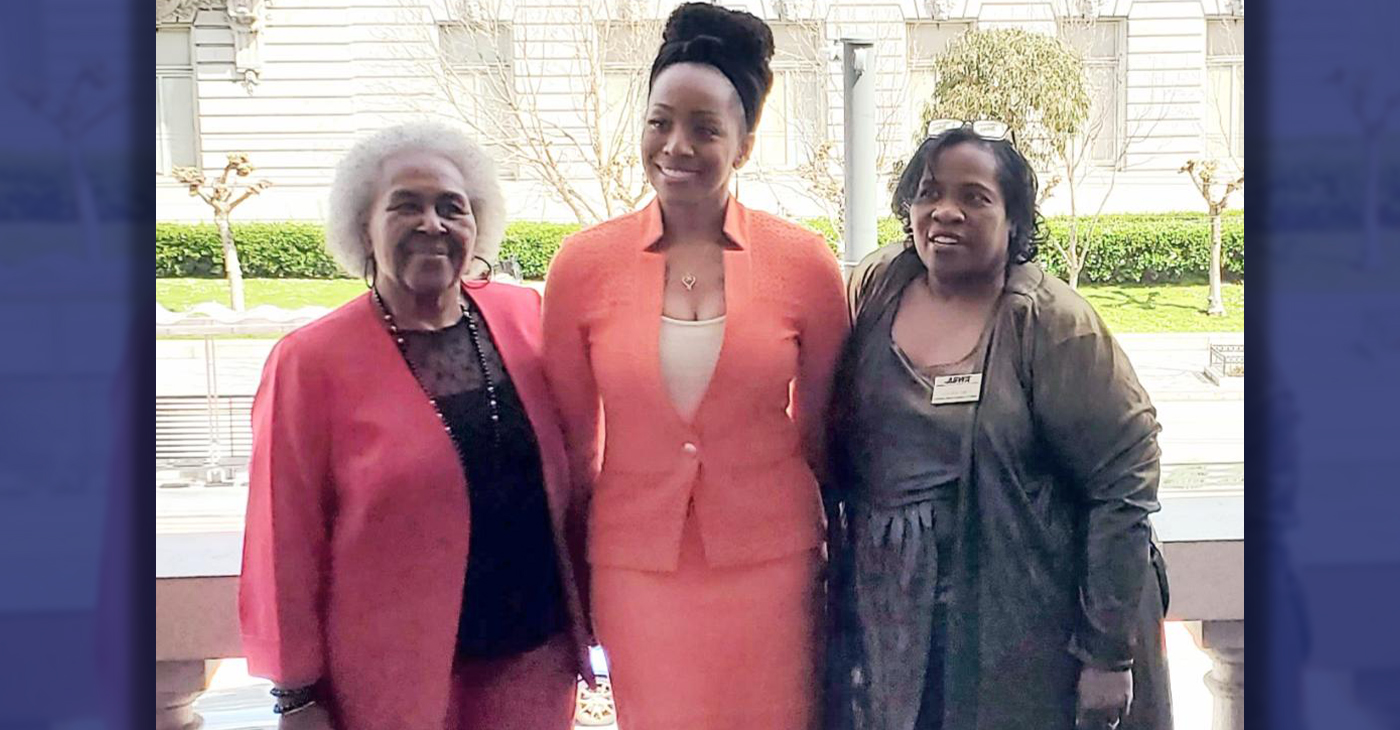
By Carla Thomas
California State Controller Malia Cohen delivered the keynote speech to over 50 business women at the Black Wealth Brunch held on March 28 at the War Memorial and Performing Arts Center at 301 Van Ness Ave. in San Francisco.
The Enterprising Women Networking SF Chapter of the American Business Women’s Association (ABWA) hosted the Green Room event to launch its platform designed to close the racial wealth gap in Black and Brown communities.
“Our goal is to educate Black and Brown families in the masses about financial wellness, wealth building, and how to protect and preserve wealth,” said ABWA San Francisco Chapter President LaRonda Smith.
ABWA’s mission is to bring together businesswomen of diverse occupations and provide opportunities for them to help themselves and others grow personally and professionally through leadership, education, networking support, and national recognition.
“This day is about recognizing influential women, hearing from an accomplished woman as our keynote speaker and allowing women to come together as powerful people,” said ABWA SF Chapter Vice President Velma Landers.
More than 60 attendees dined on the culinary delights of Chef Sharon Lee of The Spot catering, which included a full soul food brunch of skewered shrimp, chicken, blackened salmon, and mac and cheese.
Cohen discussed the many economic disparities women and people of color face. From pay equity to financial literacy, Cohen shared not only statistics, but was excited about a new solution in motion which entailed partnering with Californians for Financial Education.
“I want everyone to reach their full potential,” she said. “Just a few weeks ago in Sacramento, I partnered with an organization, Californians for Financial Education.
“We gathered 990 signatures and submitted it to the [California] Secretary of State to get an initiative on the ballot that guarantees personal finance courses for every public school kid in the state of California.
“Every California student deserves an equal opportunity to learn about filing taxes, interest rates, budgets, and understanding the impact of credit scores. The way we begin to do that is to teach it,” Cohen said.
By equipping students with information, Cohen hopes to close the financial wealth gap, and give everyone an opportunity to reach their full financial potential. “They have to first be equipped with the information and education is the key. Then all we need are opportunities to step into spaces and places of power.”
Cohen went on to share that in her own upbringing, she was not guided on financial principles that could jump start her finances. “Communities of color don’t have the same information and I don’t know about you, but I did not grow up listening to my parents discussing their assets, their investments, and diversifying their portfolio. This is the kind of nomenclature and language we are trying to introduce to our future generations so we can pivot from a life of poverty so we can pivot away and never return to poverty.”
Cohen urged audience members to pass the initiative on the November 2024 ballot.
“When we come together as women, uplift women, and support women, we all win. By networking and learning together, we can continue to build generational wealth,” said Landers. “Passing a powerful initiative will ensure the next generation of California students will be empowered to make more informed financial decisions, decisions that will last them a lifetime.”
-

 Activism4 weeks ago
Activism4 weeks agoOakland Post: Week of March 27 – April 2, 2024
-

 #NNPA BlackPress4 weeks ago
#NNPA BlackPress4 weeks agoBeloved Actor and Activist Louis Cameron Gossett Jr. Dies at 87
-
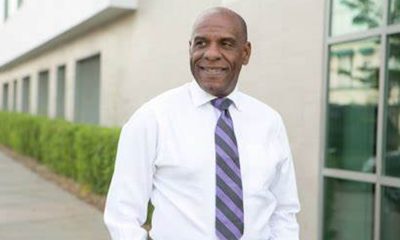
 Community1 week ago
Community1 week agoFinancial Assistance Bill for Descendants of Enslaved Persons to Help Them Purchase, Own, or Maintain a Home
-
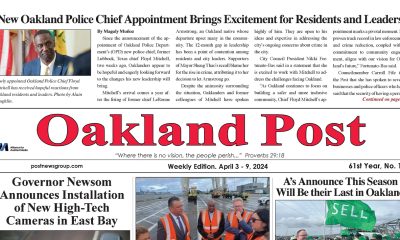
 Activism3 weeks ago
Activism3 weeks agoOakland Post: Week of April 3 – 6, 2024
-

 Business1 week ago
Business1 week agoV.P. Kamala Harris: Americans With Criminal Records Will Soon Be Eligible for SBA Loans
-
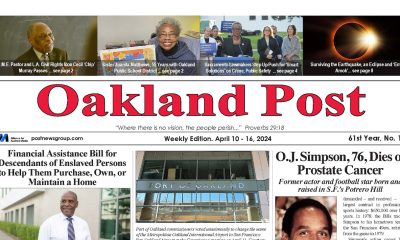
 Activism2 weeks ago
Activism2 weeks agoOakland Post: Week of April 10 – 16, 2024
-
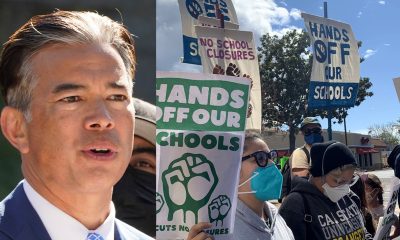
 Community1 week ago
Community1 week agoAG Bonta Says Oakland School Leaders Should Comply with State Laws to Avoid ‘Disparate Harm’ When Closing or Merging Schools
-
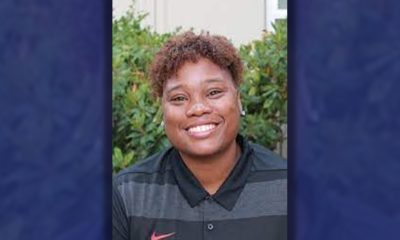
 Community6 days ago
Community6 days agoOakland WNBA Player to be Inducted Into Hall of Fame

